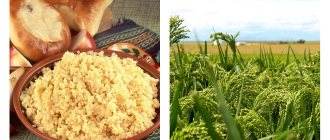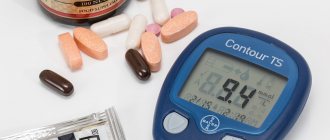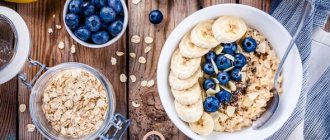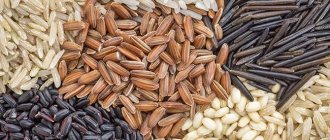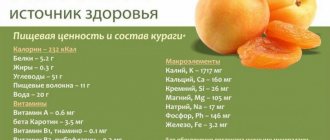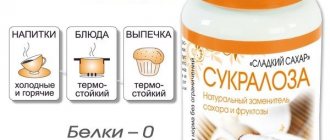Diabetes mellitus is an autoimmune disease caused by impaired metabolism, which is characterized by high concentrations of glucose in the blood. Often the disease progresses and leads to complications such as atherosclerosis, heart attack, stroke and even premature death. With elevated sugar, the patient must constantly monitor his daily diet. Let's figure out whether it is possible to eat cereals and porridges if you have type 2 diabetes?
What cereals can you eat if you have diabetes?
For type 2 diabetes mellitus, buckwheat porridge has the maximum benefit.
A properly prepared dish saturates the body with energy, vitamins, and has a beneficial effect on blood vessels. It is also important that buckwheat porridge has a low glycemic index, which is equal to 50. Buckwheat is recommended by endocrinologists for daily consumption
It contains more than 18 amino acids, it is rich in proteins, it contains magnesium, iron and folic acid.
It is worth noting that a high concentration of amino acids in buckwheat can provoke allergies in people with individual intolerance.
In second place in terms of healthiness is oatmeal, the glycemic index of which is 40. If you have diabetes, you can eat this porridge every day, for example for breakfast.
Features of oatmeal for diabetes:
- Contains a large amount of fiber.
- Low calorie content.
- Contains natural antioxidants.
- Oats are a natural source of inulin, so consuming this porridge every day can reduce the body's need for insulin.
Pearl barley porridge has a glycemic index of 22. The cereal is obtained by grinding barley. Due to the low glycemic index, there are no restrictions on the consumption of such cereals for type 1 diabetes, as well as type 2.
Barley contains a lot of gluten and vitamins. When using the product on a regular basis, toxic substances and waste are removed from the human body, metabolic processes are improved, and the aging process slows down.
It is not recommended to eat pearl barley during pregnancy, as well as if you are predisposed to increased gas formation, and if you have a history of stomach ulcers.
For diabetes mellitus, barley enriches the patient’s body with iron, calcium, potassium, magnesium, and zinc.
Features of barley groats:
- Barley-based porridges contain a lot of dietary fiber, which is absorbed by the body over a long period of time, which allows you to be full for several hours and forget about the feeling of hunger.
- Dishes from the barley group simultaneously have a therapeutic and preventive effect.
Pea porridge for diabetes mellitus helps reduce the risk of developing cardiovascular diseases, arterial hypertension, and kidney pathologies. It cleanses the body of toxins and toxic substances.
Semolina porridge for diabetes, despite its beneficial composition, will not benefit a diabetic, so it is not recommended to eat it. Also, it has a high glycemic index.
Studies have shown that semolina porridge for type 1 and type 2 diabetes mellitus leads to a lack of calcium in the patient’s body. As a result, the digestive system tries to compensate for its deficiency from the circulatory system, and the latter cannot restore it on its own.
Rice porridge for diabetes helps normalize blood sugar levels and maintain them at the required level.
When choosing cereals, it is better to give preference to oblong-shaped white rice, and ideally, the cereal should be brown or brown, that is, with a minimum of processing.
What do you eat them with?
It is also important what to combine the permitted side dishes with. For diabetes, these should be foods rich in fiber that can lower the GI:
- fresh herbs;
- salads from raw vegetables (without mayonnaise);
- mild, unsweetened and low-fat sauces.
Your doctor can recommend a recipe for a healthy salad or addition to your porridge. The patient’s task is to eat fractionally (small portions, but often), monitor blood sugar levels and follow other recommendations of the endocrinologist.
Rules for preparing porridge
Diabetes mellitus dictates its own rules for preparing porridges.
Let's look at some of them.
- It is advisable to cook porridge in water. Milk can be added at the end of cooking.
- Of course, the use of sugar is prohibited (you can add a teaspoon of honey to the finished porridge if there are no contraindications).
- It is better to rinse the cereal before use. As you know, cereals contain starch, which is a polysaccharide. Usually it envelops the grain, so it is important to wash off the top layer by rubbing the grain in your hands.
- It’s better not to cook porridge, but to brew it. Take a portion of cereal, pour boiling water (kefir) and leave overnight. This way all the beneficial substances will remain in the porridge.
Due to the chronic course of the disease, dieting is a way of life with diabetes.
It is important to know that violation of the diet threatens the patient with hyperglycemic coma or even death. It is necessary not only to limit or eliminate harmful foods, but also to consume more healthy ones.
To cope with the disease, vitamins are needed. The daily diet often cannot replenish the entire daily requirement of vitamins and microelements, so you should resort to nutritional supplements (on the recommendation of a doctor).
Recipes
To make the menu as balanced and varied as possible, you can alternate cereals and experiment with different recipes. The most common way to prepare cereals is as a second course. Diabetics are advised to cook porridge in water without adding spices or oil. You can add a little salt. Porridge is served with vegetables, lean meat and fish. A single dose of boiled cereal should not exceed 200 g (4–5 tbsp.).
Pilaf
Brown rice can be prepared in the form of a complex dish - pilaf.
The cereal is thoroughly washed and boiled in water in a ratio of 1:2. Zirvak, the basis for pilaf, does not need to be cooked separately, since the dish should be as low-calorie and low-fat as possible. Chopped meat, carrots, and raw onions are mixed with rice and poured with boiling water. Cook the dish in a slow cooker or over a fire for 40–60 minutes. For flavor, you can add a couple of cloves of garlic, add a little salt and pepper.
For diabetes mellitus, it is recommended to cook porridge in water without adding oil or spices.
Porridge with milk
Porridges with a low glycemic index, especially pearl barley, oats, buckwheat, and brown rice, can be cooked in milk.
In this case, you should take the cereal and dilute it with water in a 1:1 ratio. You also need to reduce the amount of cereal consumed per meal by 1–2 tbsp. l. It is better to eat milk porridge warm and in the morning. It can be slightly seasoned with salt or sweetened with a sweetener. In moderate quantities, a combination of milk porridge with fruits is allowed: unsweetened apples, raspberries, blueberries.
Soup with cereals
For lunch, it is recommended to prepare soup with cereals. If desired, add separately cooked pieces of meat or fish - fatty broth is prohibited for diabetics.
Barley porridge
The product is high in calories, however, it contains substances important for the body of diabetics:
- vitamin A – needed for the functioning of the visual analyzer, strengthens the immune system, prevents the development of infectious processes, promotes rapid regeneration of the skin;
- B-series vitamins – participate in all processes of the nervous system and metabolism;
- vitamin D – supports the functioning of the musculoskeletal system, the transmission of nerve impulses;
- tocopherol - considered a powerful antioxidant responsible for the regeneration and rapid restoration of the skin and mucous membranes;
- nicotinic acid – stimulates the metabolism of lipids and carbohydrates, removes excess cholesterol, activates the pancreas, dilates blood vessels, prevents the development of cardiac pathology;
- phosphorus – supports the functioning of the liver and pancreas, accelerates metabolic processes;
- other useful microelements and substances (fluorine, chromium, boron, silicon, zinc).
Important! Recipes for preparing barley groats emphasize the possibility of using it not only as side dishes, but also for first courses.
The benefits of a tiny seed
Flax seed is collected from a well-known plant, which in Russia was used only industrially for the manufacture of fabrics. The beneficial properties of the seed were noticed by domestic biologists and nutritionists in the 90s.
The seeds are small in size, oblong in shape and brown in color.
The fresh product is distinguished by its shine, which disappears from the stale seed. Seeds should be stored at a temperature from +5 to +15 degrees, in a dark place. Better in a glass jar or closed paper bag.
You should not purchase large quantities of seeds at once, since during storage they may become infected with bugs and other microorganisms. Gardeners can grow the seeds themselves. To do this, seeds are sown in a pre-selected, sunny place. In July, flax will delight you with abundant blue blooms; seeds will appear by autumn. Which are collected, cleaned and dried.
The product contains the following components:
- Starch is necessary for the normal functioning of the gastrointestinal tract during weight loss;
- Omega-3 acids, which are necessary for lipid metabolism in the body;
- Omega-6 acids. Normalize the functioning of the nervous system and increase the healing of ulcers and small wounds;
- Lecithin, which is involved in the restoration of liver cells;
- Monosaccharides and disaccharides are simple carbohydrates that are easily digested. Allowed in small quantities for type 2 diabetes;
- Minerals: calcium, potassium, iron, copper, phosphorus, sodium, magnesium;
- Vitamins: B6, B12, C, PP, K, E;
- Proteins and fats.
Flax seed is a complete product that can be used to replace one of the daily meals or be used as a supplement for several months.
The method and dosage are selected individually depending on the complexity and type of diabetes in the patient. Diabetes of the second type is acquired by patients with age. Basically, the disease occurs in people who neglect a healthy lifestyle and are overweight.
Patients of the second type have concomitant ailments:
- Disturbance in the functioning of the pancreas;
- Hormonal imbalance;
- Swelling of the extremities, venous insufficiency;
- Urolithiasis disease.
Flax seeds contain plant fibers, which improve the functioning of the gastrointestinal tract and normalize metabolic processes in the body. When combining phototherapy with a proper lifestyle and dietary nutrition, patients of the second type note improvements in their well-being.
With regular consumption of the product, the following changes are observed:
- Reduces blood cholesterol levels;
- Patients' constipation goes away, stool returns to normal;
- The functioning of the kidneys and liver is normalized;
- The elasticity of blood vessels increases;
- Swelling and pain in the legs disappear;
- Blood circulation improves;
- Excessive skin dryness, flaking and itching disappear.
The positive effect on the epidermis is associated with a large amount of omega 3 and 6 acids. Compared to fish oil, there are twice as many of them in flax seed. Therefore, it is additionally recommended to lubricate the skin with linseed oil. It will accelerate regeneration, give skin elasticity and nourish cells.
Despite the benefits, you can only consume flax seeds after consulting your doctor. Phototherapy is not always suitable for patients with diabetes, especially if the patient is insulin dependent.
Product Features
For diabetics, it is important to consider the following characteristics of products and dishes based on them:
- The glycemic index (GI) is an indicator that specifies the rate of rise in blood sugar after a certain product enters the body.
- Insulin index (II) is an indicator that specifies how much insulin is needed to normalize glycemia after including certain foods or substances in the diet.
- Calorie content (energy value) - shows how much energy a person will receive after breaking down a particular product or dish into small components.
- Chemical composition - the presence of proteins, fats, carbohydrates, microelements, vitamins, acids and other organic and inorganic substances in the composition.
Porridge is a dish that can be included in a diabetic’s menu every day.
Important! It is on the basis of these indicators that patients create an individual diet and schedule a menu, trying to diversify it, but at the same time exclude or limit prohibited foods.
Pea porridge
Experienced nutritionists recommend, and insistently, that pea porridge be used in the menu of diabetics. It contains many useful elements. The presence of a rich complex of components helps improve the functioning of the inflamed gland.
Recipe
- Peas need to be soaked overnight;
- Then transfer the product to boiling water with salt;
- Cook until completely thick;
- The dish must be stirred constantly during cooking;
- Upon completion of cooking, cool and use for any type of pathology.
How to cook for diabetics
Porridges for diabetics will be most beneficial if they are prepared correctly. To do this, you should follow some simple recommendations.
All cereals must be washed before cooking.
This removes starch from them, which can be harmful to diabetics.
To preserve all the nutrients as much as possible, it is recommended not to cook the cereals, but to pour boiling water over them, cover with a lid, wrap them in a warm towel, and leave for several hours. A dish prepared in this way will be very useful for dietary nutrition.
If a person wants to cook a dish, it is better to use water for this. It is not recommended for diabetics to cook with milk. Occasionally, to diversify the diet, a little milk can be added at the end of cooking or in the finished dish. To improve the taste, if there are no contraindications, you can add a little honey, fruit or stevia extract to the porridge instead of sugar.
Butter will have to be replaced with vegetable oil.
Allowed and prohibited for type 2
Taking into account the glycemic index is of particular importance in the second type of disease. If the patient has concomitant obesity, then it is necessary to completely avoid the following types of cereal products:
- muesli, granola, small instant oat flakes, mixtures with sugar in bags;
- white rice, rice flour pasta;
- semolina, couscous;
- corn;
- millet.
Benefits for patients are:
- buckwheat,
- pearl barley,
- oatmeal,
- wild or black rice,
- quinoa.
All other cereals can also be included in the menu once or twice a week in order to diversify the diet.
Buckwheat porridge with vegetables
If you are obese, porridge is limited. It is not recommended to eat them every day, and it is better to use fresh or boiled vegetables as a side dish, except potatoes, beets and carrots. The porridge is prepared in water, and when serving, you can add a little milk to it. Cereals, vegetables and herbs go well together.
What is better to refuse
Some cereals do not benefit diabetics, but on the contrary can significantly worsen their health. This is due to the high carbohydrate content in such products and significant calorie content. These include:
- polished rice;
- instant oatmeal;
- semolina.
Eating the above cereals causes blood glucose levels to rise sharply. As a result, the risk of developing diabetes complications increases. The most severe of them include retinopathy, diabetic foot syndrome, tissue sensitivity disorders, etc. The condition of a patient with type 2 diabetes directly depends on two factors: adherence to diet and regular use of medications. If you neglect the first one and eat foods high in carbohydrates, there will be no point in using medications.
There are almost no valuable substances in semolina porridge, white rice and oatmeal; these products simply make you feel full. If the patient had to eat such a dish once or twice, nothing terrible will most likely happen. But systematic consumption of such cereals will result in obesity and complications of diabetes.
Healthy cereals with a low and medium glycemic index are the basis of the menu for patients with diabetes. By consuming such foods, the body is saturated with carbohydrates, which are necessary for the formation of energy and proper functioning of the brain. When choosing a type of cereal, it is necessary to take into account its composition and sugar content in it. With this approach, dishes will bring not only the joy of a pleasant taste, but also benefits.
Cooking features
Type 2 diabetes mellitus is a disease that largely depends on the compensatory capabilities of the pancreas. Over time, it depletes its reserves, and the disease progresses.
To prevent such developments, it is necessary to follow a diet. The patient receives basic information from the attending physician. However, the patient himself must understand how to shape his diet to stabilize his own condition.
The further development of diabetes in a particular person may depend on how the corn porridge is prepared. There are several important points to remember to create a tasty, healthy dish:
- During cooking, cereals should be taken in a ratio of 1 to 2 with water. 100 g of porridge is boiled using 200 ml of water;
- The duration of the cooking process should be 25 minutes;
- You need to season the side dish with vegetable oil (olive, sunflower). The creamy product is not suitable for this purpose. It very sharply increases the glycemic index of the dish;
- It is important not to overcook the cereal. The thicker it is, the worse it is for the patient’s carbohydrate metabolism.
The average portion should be 150 g. It can be used as a single dish or combined with others. Corn porridge goes well with the following delicacies:
- Steamed beef cutlets;
- Stewed chicken liver with gravy (without adding flour);
- Fish cutlets;
- Boiled chicken breast with vegetables.
In most cases, menu selection depends on the dietary content of accompanying dishes and the taste preferences of a particular patient.
Corn porridge
The dish belongs to the group of products with an average glycemic index (it varies depending on the thickness of the porridge and its constituent components). Corn is considered a storehouse of useful substances that are so necessary for a sick body. Porridge contains a significant amount of dietary fiber, which is absorbed by the body for a long time.
Corn-based porridge is a dish that will decorate the table of not only sick people, but also healthy people
Corn porridge contains the enzyme amylase, which slows down the process of sugar entering the bloodstream.
Important! But you need to give up corn flakes. The technology for their preparation consists of such a huge number of stages that the final product is practically devoid of useful substances
In addition, it has higher GI numbers.
Corn porridge
To prepare maize porridge you will need 200 g of cereal and 600 ml of lightly salted water. Cook the side dish for about 40 minutes over low heat. To prevent the porridge from burning, it is cooked in cast iron. After cooking, cool.
For taste, you can prepare a sauce based on parsley, cilantro, garlic and olive oil. The ingredients are mixed in a blender and the prepared seasoning is poured over the porridge. This dish is suitable for people with physical inactivity. The high fiber content prevents carbohydrates from quickly penetrating into the bloodstream. Therefore, the risk of blood sugar spikes is reduced. It is useful to give to children as a side dish with protein meat products.
Wheat cereal Glycemic Index45
Wheat cereal contains a high fiber content, which stops the accumulation of fat from excess glucose, and also normalizes intestinal function. Wheat cereal contains pectins, they slow down the processes of decay and stimulate the improvement of the condition of the intestinal mucosa.
Wheat cereal is rich in fiber, it stimulates the intestines and blocks the process of converting sugar into fats
We advise diabetics to make a decoction of wheat flour: add a tablespoon of wheat bran, pour a glass of milk or boiling water, stir. Take one tablespoon of decoction 2-3 times a day during meals.
Millet porridge
Millet has a low glycomic index (40) and occupies a priority place in the diet of diabetic patients. Millet porridge is prepared in water. It does not cause complications and can be consumed together with low-fat broth and even a small piece of butter.
Millet is useful for diabetics:
- amino acids that stabilize metabolic processes;
- nicotinic acid (vitamin PP), which normalizes lipid metabolism, removes harmful cholesterol, and improves the functional abilities of blood vessels;
- folic acid, which stabilizes blood formation and improves metabolic processes;
- proteins (inositol, choline, lecithin), which help stabilize cholesterol metabolism and produce lipotropic work;
- manganese, which normalizes weight;
- iron, which promotes the formation of blood cells;
- potassium and magnesium, which support the cardiovascular system;
- pectin fibers and fiber, which remove waste and toxins from the intestines, and also contribute to the slow absorption of complex carbohydrates.
Millet porridge helps to break down and eliminate fat cells from liver cells, as well as remove harmful elements that form in the body due to the breakdown of medications.
The porridge is hypoallergenic, has a diaphoretic and diuretic effect and normalizes the functions of the gastrointestinal tract.
According to some experts, systematic consumption of millet porridge for diabetes can completely relieve the disease.
Contraindications include: a tendency to constipation, hypothyroidism and increased gastrointestinal acidity.
Rice porrige
A 2012 study allowed scientists to conclude that white rice is harmful for people with diabetes. The product causes excess weight, which provokes type 2 diabetes. Rice also has a significant glycemic index (white - 60, brown - 79, for instant cereals it reaches 90).
Eating brown (unpolished rice) has a beneficial effect on diabetics. Its dietary fiber lowers the percentage of sugar in the body, and folic acid ensures a normal balance. Brown rice is rich in vitamin B1, which supports the cardiovascular and nervous systems, as well as valuable micro- and macroelements, fiber and vitamins.
The inclusion of rice bran (GI 19) in the diet has a beneficial effect on the body affected by diabetes.
Considering what cereals can be consumed if you have diabetes, it becomes possible to adjust the menu for a long time and not lose the pleasure of eating.
Oatmeal on the diabetic menu
Oatmeal is a truly unique product that is suitable for feeding patients with type 1 and type 2 diabetes for three reasons:
- optimizes the functioning of the digestive system and liver;
- normalizes carbohydrate and lipid metabolism;
- has a beneficial effect on the state of intestinal microflora.
The above-described properties of oatmeal are due to its microelement composition, which contains:
- a plant analogue of human insulin - inulin;
- healthy vitamins and minerals;
- fiber, which slows down the absorption of carbohydrates from the digestive tract.
Of course, whole grain oatmeal is the healthiest, but we often see oat flakes on sale. If this is not an instant product, but simply flattened grain, then almost all the properties of oatmeal are preserved in it, so porridge can be prepared from it.
Instant oatmeal has a high glycemic index (GI = 66)!
It is advisable to cook oatmeal for a diabetic patient using water. If you want sweet milk oatmeal, then it is better to add milk, sweetener, nuts and fruits to the ready-made porridge. Naturally, you need to take into account the additional carbohydrates that will end up in your daily diet in this case.
The recipe for oatmeal with water is offered in the following video:
Very useful for any diet, including diabetic ones, oat bran. It is pure insoluble fiber with the following properties:
- activates digestion;
- promotes the removal of waste and toxins;
- significantly reduces the glycemic index of foods with which it is consumed.
Oat bran can be added to the same porridge and any other dishes. However, this useful product should be consumed in doses - an average of 2 tablespoons per day. Excess fiber overloads the digestive system and can lead to malfunctions.
Barley and pearl barley porridge
Pearl barley and barley porridge are the best choice for the diet of diabetics. Both represent barley, in one case whole grains, in the other crushed.
The composition of the porridges is similar, however, the rate of absorption is different. Thus, the breakdown of whole grain pearl barley lasts a longer period of time (GI 22), as a result of which it has great dietary value for diabetes types 1 and 2.
Cereals are rich in fiber and represent 1/5 of the daily value of plant-based proteins.
The benefits of cereals
Porridge for diabetics can be a healthy side dish or main dish. For proper introduction into the diet, you need to take into account their beneficial properties.
Buckwheat
It contains a lot of iron, protein, and B vitamins. When growing this crop, pesticides and fertilizers are rarely used, so it can be considered the least dangerous. In addition, it itself can remove heavy metal salts from the body. Buckwheat does not contain gluten, a protein to which some patients are intolerant and considered responsible for the progression of autoimmune diseases.
The glycemic index of cereal is 50. This is an average. In order not to increase it, diabetics should not use traditional boiling, but steam the cereal with boiling water. This can be done in a thermos or thick-walled pan. In the latter case, she is tightly wrapped in a blanket for an hour. The usual proportions of cereal and water are 1:2.
We recommend reading the article about bread units for diabetes. From it you will learn why and how to count bread units for diabetes and how to take carbohydrates into account when calculating.
And here is more information about the diet for diabetic nephropathy.
Oatmeal
Oat grains have the advantage that their regular consumption increases the activity of the immune system, which is extremely important for diabetes. To preserve all biological properties, you need to use not flakes, but oatmeal
It is thrown into boiling water and boiled for 20 minutes, then allowed to brew for another 15 minutes in a sealed container.
This porridge improves the functioning of the digestive system, promotes muscle strength, and removes excess fluid and cholesterol from the body. The grain contains a lot of magnesium and folic acid, which are useful when bearing a child.
Turkey glycemia is the same as that of buckwheat, so diabetics should not combine it with raisins and dried fruits. A good addition would be fresh apple and cinnamon, cottage cheese.
Millet
Is the seed of millet. When stored for a long time, it loses its taste due to the high content of vegetable fats. Millet porridge improves skin structure and has an intense cleansing effect. In order to preserve the vitamins contained in the grains, it is better to pre-rinse the millet at least 5-6 times in plenty of water and leave to soak overnight. This reduces the cooking time of the porridge.
A negative property is the high glycemic index - it is equal to 70. Therefore, it is better to leave the cereal for preparing the first course, adding it to cottage cheese casserole, stuffed peppers instead of rice.
Pearl barley
The barley from which the cereal is produced has the following effects on the body:
- reduces inflammation, has an antibacterial effect;
- stimulates mental activity;
- strengthens bones and muscle system;
- increases bile secretion;
- activates intestinal function;
- reduces body weight.
Pearl barley has the lowest glycemic index, which allows it to be recommended to patients. Contraindicated in case of exacerbation of pancreatitis, gastritis and cholecystitis.
Wheat
The grains contain valuable amino acids and antioxidants. Eating porridge helps:
- improve fat metabolism;
- strengthen the walls of blood vessels;
- prevent the progression of atherosclerosis;
- activate the functioning of the fibers of the nervous system;
- bring blood pressure levels back to normal.
Semolina is obtained from wheat; it is a finely ground grain without its shell. Its benefits are much lower. Also used in food is couscous, which is obtained from glued grains of semolina and bulgur. The last cereal is steamed crushed wheat. The glycemic index of wheat is 50, and semolina is 85 units.
Corn
Thanks to its complex vitamin composition (A, E, group B), copper, iron and calcium content, corn porridge is useful for weakened patients. It is recommended for vascular diseases and decreased immune defense. Corn is well digestible even in childhood. In diabetes mellitus, there is a factor limiting its widespread use - a high glycemic index. It's approaching 70.
Porridge for diabetics
Diabetes mellitus is an irreversible disease that requires constant monitoring and compliance with all recommendations of an endocrinologist.
In addition to the mandatory hypoglycemic (sugar-lowering) and insulin medications, the diabetic is prescribed therapeutic food “Table No. 9”. A diabetic diet is based on proteins and complex carbohydrates.
The latter include cereals for diabetes, the use of which is strictly regulated by diet rules.
Three basic rules for choosing products
All products, including grains and cereals, for the diabetic menu are selected according to three main criteria:
- Glycemic index (GI). Allowed food, indexed from 0 to 30 units. Limited products are products with GI from 30 to 70 units. A higher glycemic index is not acceptable for diabetics.
- Energy value. The diet of diabetics should not contain high-calorie foods. This is especially true for patients with type 2 diabetes who are obese.
- nutrients in a dish (product). Simple carbohydrates (confectionery and other sweets) are eliminated from the menu. The emphasis in nutrition is on protein foods, slow carbohydrates and fiber.
Diabetics should control portion sizes. Overeating leads to gaining extra pounds. In addition, an important parameter for type 1 diabetes is the number of bread units (XU) contained in products. Based on XE, the correct dose of insulin is calculated.
Prerogative aspects of eating cereals for patients with diabetes
For diabetics, porridge is an integral part of the diet. Firstly, cereals are complex carbohydrates. They are slowly processed by the body, without causing a forced rise in blood sugar levels. Prolonged digestion of porridge does not cause a feeling of hunger for several hours.
This is a prevention of overeating and, as a result, excess weight gain. Secondly, many cereals and grains contain a sufficient amount of dietary fiber, which helps normalize digestive processes. Thirdly, cereals contain those useful elements that are prescribed to diabetics in the form of vitamin and mineral complexes.
Almost all cereals contain the vital group of B vitamins:
- B2 (riboflavin) – normalizes the metabolism of fats and proteins, helps improve vision;
- B1 (thiamine) – has a positive effect on the blood supply to organs and tissues of the body, participates in metabolic processes;
- B5 (pantothenic acid) – takes part in the restoration of damaged cells and tissues;
- B3 (niacin) – responsible for memory and attention, regulates heart function;
- B6 (pyridoxine) – activates the conduction of nerve impulses, increases blood circulation in brain cells, stabilizes the functioning of the nervous system;
- B4 (choline) – prevents the development of visceral obesity;
- B12 (cyanocobalamin) – normalizes the activity of the psycho-emotional state and the activity of the nervous system.
- B9 (folic acid) – eliminates sleep disorders.
Cereals contain minerals, essential amino acids, and polyunsaturated fatty acids.
Cereals on the menu for diabetics
Before you start developing a daily menu, you need to find out what kind of cereals a person with diabetes can eat. Only cereals that meet the criteria of the diabetic food basket are allowed in the diabetic diet. In addition, cereals come in different varieties, which also needs to be taken into account when choosing.
Reference! During the cooking process, any cereal absorbs water, which reduces its energy value by 2-3 times.
Buckwheat comes in two types: crushed and whole grain. In case of diabetes, preference should be given to the kernel. It contains a higher percentage of B vitamins, as well as the following micro- and macroelements:
- potassium and magnesium – are responsible for stable heart function;
- iron – prevents the development of anemia (anemia);
- calcium and phosphorus – support healthy bone tissue;
- zinc and manganese – promote the synthesis of natural insulin.
Buckwheat contains lysine, tryptophan, leucine, and arginine. These are essential amino acids that the body urgently needs, but is unable to produce on its own. The energy value of the kernel is 308 kcal/100 g. Buckwheat boiled in water without seasonings and salt contains 98 kcal/100 g.
In 100 gr. crumbly buckwheat porridge contains 17.1 g. carbohydrates or 1.4 XE. The glycemic index of buckwheat is 55 units, which is beyond the acceptable GI for diabetes. Therefore, it belongs to the category of restricted foods, that is, diabetics should not indulge in buckwheat.
It would be optimal to eat buckwheat twice a week. Buckwheat compares favorably with other grain crops with its high content of vegetable protein (13 g/100 g) and fiber (12 g/100 g).
Buckwheat is good for diabetics
Barley and egg
Pearl barley and barley groats are made from a common cereal crop, barley. Yachka is unpolished crushed grains, pearl barley is peeled grain, devoid of shell. Just like buckwheat, pearl barley and barley are rich in B-group vitamins and contain tocopherol acetate, otherwise known as vitamin E. Its direct purpose is:
- strengthening the immune system;
- increasing the strength of the walls of capillaries and large vessels;
- normalization of blood glucose levels;
- maintaining the skin's regenerative capabilities.
Since cereals are made from the same raw materials, their mineral composition is the same. The difference lies in the quantitative content of micro- and macroelements.
| Microelements | Macronutrients |
| iron, manganese, copper, selenium, zinc fluorine, molybdenum | potassium, phosphorus, calcium, magnesium, sulfur |
The calorie content of the egg is 313 kcal/100 g. Porridge with water contains 76 kcal/100g. The glycemic index of the product is 40 units. The energy value of raw barley is 324 kcal/100g, boiled - 109 kcal/100g. GI is 30 units.
Regarding bread units, per 100 gr. ready-made pearl barley or barley porridge in water accounts for approximately 1.83 XE. Regular consumption of barley cereals helps cleanse the digestive tract of toxins and the body as a whole of toxic deposits.
Semolina and corn
Semolina is a derivative of wheat. Compared to other cereal crops, semolina contains a minimum of dietary fiber and a maximum of carbohydrates. Semolina porridge is quickly processed by the body and causes a rise in blood sugar levels in diabetics.
The calorie content of cereal is 333 kcal/100 g, ready-made porridge – 99 cal/100 g. The glycemic index of porridge without sugar is 75 units. For diabetics, semolina belongs to the prohibited category of food products.
Semolina porridge contains phytin, a substance that prevents the absorption of calcium and iron. Corn porridge, also known as hominy, is a filling and low-calorie dish. Raw cereal contains 328 kcal/100 g. In mamalyga – 92 kcal/100 g. Corn grits are rich in beta-carotene, vitamins B3, B5, B6, potassium and phosphorus. Contains arachidonic, linolenic and linoleic amino acids.
The disadvantage of hominy is its high glycemic index – 75 units. For diabetes mellitus, the product is not recommended. Corn flakes are not allowed in the diet. Their GI is 85 units, energy value ranges from 360 to 380 kcal/100 g. (depending on the manufacturer).
Linen
Flaxseed porridge is a dish with a unique chemical composition. It contains a large amount of Omega-3 polyunsaturated fatty acids. There is no need to add butter or sour cream to the porridge. The total fat content is 40 g/100 g.
The flax product is rich in proteins and has a significantly lower carbohydrate component than other cereals. In addition, flaxseed porridge is a leader in dietary fiber content. The vitamin complex is represented by:
- group of vitamins B;
- vitamin E;
- ascorbic acid (vitamin C) is a powerful antioxidant for strengthening the immune system and cleansing blood vessels of cholesterol.
Table of bread units for diabetics
Amount of micro- and macroelements (mg per 100g):
- potassium – 819.6;
- phosphorus – 647.4;
- magnesium – 395;
- calcium 257;
- iron 5.76;
- manganese – 2.52;
- zinc – 4.38.
The composition of nutrients determines the calorie content of the product - 298 kcal/100 g. But the glycemic index does not exceed 35 units. 2 tablespoons (heaped) contain 1 XE.
Oats
Oatmeal is prepared from whole grains or flakes - peeled oats. The vitamin and mineral composition of oatmeal is similar to buckwheat. During industrial processing of grains, cereals lose most of their valuable substances. For example, in terms of the amount of dietary fiber, Hercules oatmeal is inferior even to buckwheat.
In addition, the cereal contains increased carbohydrate content, therefore higher calorie content. Therefore, diabetic patients are recommended to cook porridge from unpeeled oats or the coarsest flakes. The glycemic index of cereals cooked in water is 40 units; when cooked in milk, the figure increases 1.5 times.
Important! Muesli is contraindicated for diabetes; its GI is 80-85 units.
These are two different products and should not be confused. Wheat groats are made from durum wheat, millet groats are made from purified millet grains. Wheat contains a large amount of fiber, vitamins B1, B2, B4, B5, B6, B9, potassium, magnesium and phosphorus.
The energy value of raw cereals is 341 kcal/100 g, ready-made wheat porridge is 111 kcal/100 g. The glycemic index of cereal does not exceed 45 units. One unit of bread contains 50-60 grams. cereals (depending on the variety). Considering that wheat boils a lot, a serving of porridge is 100 grams. does not exceed 1.3 XE.
Wheat dishes are available for diabetics due to their low glycemic index
Millet cereal is higher in calories - 378 kcal/100 g. The useful components of the product are vitamins A, E, B-vitamin complex, iron, magnesium, potassium, sulfur, calcium, fluorine, manganese, etc. The main valuable property of millet porridge is its ability to stimulate the production of natural insulin and regulate metabolic processes.
Endocrinologists recommend consuming millet porridge on a regular basis for prediabetes and diabetes. The glycemic index of cereals is 40-50 units. Millet can be cooked in water and 1.5% milk.
Rice
Diabetics need to be extremely careful with rice cereal. Plain white rice has a high glycemic index because it contains a lot of starch and simple carbohydrates.
White grains should be avoided. For people with diabetes, brown (brown) and black varieties of rice with a GI of 50 units are allowed on the menu. In 100 gr.
Ready-made rice porridge in water contains 2 XE and 110 kcal.
More information about peas and lentils
Peas and lentils are legumes recommended for consumption in diabetes mellitus. Legumes are rich in fiber, a healthy plant protein. Lentils and peas contain vitamins, amino acids, and minerals. Dishes made from legumes make you feel full for a long time.
According to the glycemic index, products belong to the permitted category (GI = 30 units). In terms of energy value, pea porridge contains 84.5 kcal/100 g, lentil porridge – 93 kcal/100 g. For bread units, the approximate content is 1 XE = 60g. ready dish.
Diabetic rules for cooking and eating porridge
In order not to provoke an attack of hyperglycemia (increased glucose levels in the blood), porridges for diabetics are prepared in compliance with certain conditions:
- the basis is water or milk with a fat content of no more than 1.5%;
- It is prohibited to add sugar; it is replaced with fresh or frozen berries, dried fruits (except raisins), and nuts;
- it is necessary to wash the cereal to remove excess starch;
- butter is allowed in the compensated stage of the disease, no more than 5 grams. per serving (diabetologists recommend replacing tea oil with 10% sour cream);
- It is better to eat viscous porridge for breakfast;
- It is not recommended to cook oatmeal; they should be brewed with boiling water and left to infuse;
- the volume of the dish cannot be exceeded (a single serving for type 2 diabetes is 200 grams, for type 1 diabetes it is calculated according to XE):
- cereals with a glycemic index of more than 40 are allowed only with stable glycemic compensation (you can lower the GI of the finished dish if you pre-soak the cereal, cook it al dente and cook it until ready, wrapped in a blanket);
- semolina porridge and hominy are excluded from the diet;
- you should choose whole buckwheat grains, unrefined oat grains or coarse oat flakes for cooking;
- Instant porridges should be eliminated from the menu.
As a side dish, cereal dishes go well with boiled (baked) chicken, turkey, and fish. Buckwheat and pearl barley go well with mushrooms. Recipes for making viscous porridges for diabetics differ from traditional recipes in the absence of sugar.
From boyar-style buckwheat porridge, you should exclude the brisket; do not fry vegetables (onions and carrots), but only simmer a little in olive oil. Millet porridge with pumpkin should be avoided, since the dish has a high GI.
On a note! Diabetologists recommend adding a tablespoon of bran to a serving of viscous porridge. This will help speed up metabolism and enrich the dish with minerals and vitamins.
Porridges are healthy and satisfying dishes, the presence of which is necessary in the diabetic menu. When choosing cereals, you need to be guided by the glycemic index value. Diabetics are prohibited from eating semolina porridge, hominy and cereal dishes made from white rice.
The most useful options would be buckwheat, pearl barley, barley, oatmeal, and flaxseed porridge. It is recommended to prepare water-based porridge; replace butter with 10% sour cream. Dishes made from legumes (pea and lentil porridge) can dilute the cereal diet.
Linen
Flaxseed porridge is not as common as buckwheat, oatmeal or wheat. However, it has no less useful properties and a pleasant taste. You can prepare cereal from flax seeds at home by grinding them in a coffee grinder. There is no need to boil the resulting raw material - just steam it with hot water and leave for 15 minutes (during this time the dietary fiber will swell). Flax seeds can be mixed with other healthy grains or used as an independent ingredient for cooking.
Flax contains omega acids, which are necessary for patients with diabetes. These substances normalize cholesterol levels, improve the condition of skin and hair, and also stabilize blood pressure. In addition, flax seed porridge is useful for patients with chronic gastritis and other digestive diseases. It envelops the gastric mucosa and normalizes acidity. Patients who have stones and salts in the bladder or kidneys should not eat this dish.
Regular consumption of flax seeds prevents the worsening of chronic endocrinological pathologies
Rice
In case of diabetes, preference should be given to the brown variety of cereals; it does not undergo the process of grinding and purification, therefore it retains most of the nutrients, compared to white rice.
The shell of unprocessed rice grain contains the bulk of minerals
Properties of rice:
- strengthens the nervous system;
- cleanses the body of harmful substances;
- normalizes intestinal function;
- helps remove excess fluid from the body.
When composing the diet of a patient with diabetes, it is necessary to consider which cereals can be consumed daily and which should be excluded in order to avoid negative effects on the body.
What cereals are good for diabetics
There are several points to consider when choosing a daily treat:
- Calorie content;
- Glycemic index (GI);
- Percentage of fiber and vitamins.
The following dishes will be the most nutritious for the body of a patient with persistent hyperglycemia:
- Oatmeal. "Queen" among similar products. Oddly enough, it is this porridge that ranks first among all other grains. Her GI is 49, which is an average result. However, the high content of B vitamins determines its leadership. Since diabetics often develop polyneuropathy, eating oatmeal can significantly slow down the process of nerve damage, and in some mild cases, reverse it. The presence of iodine, magnesium, and potassium has a positive effect on the cardiovascular system. It is recommended to prepare cereals with the addition of nuts, low-fat milk, vegetables (pumpkin) and fruits. It is not advisable to use kefir and butter. The parallel use of any fatty foods leads to increased absorption of carbohydrates.
- Buckwheat. Glycemic index – 50. This product is rich in essential amino acids (methionine, tryptophan, threonine, arginine and others), folic acid and iron. It can easily be used as a daily side dish. It provides the body with essential minerals and vitamins and is one of the few foods allowed for pregnant women with the sweet illness.
- Corn porridge or hominy. The product is rich in vitamin E and potassium. It has a high calorie content, but does not cause an increase in the patient’s body weight. GI – 40. Positively affects the body’s lipid metabolism, reducing the amount of “bad” cholesterol in the blood. The only significant disadvantage is the poor digestibility of the proteins of this cereal. Thus, it is not advisable to consume it in large quantities for people who are underweight.
- Pearl barley. Glycemic index - 22. Low calorie content and low carbohydrate content are great for diabetics. However, it contains large amounts of gluten. This substance stimulates the process of gas formation in the intestines. One of the common manifestations of type 2 “sweet disease” therapy using Metformin is bloating and constipation. That is why the combination of pearl barley and sugar-lowering agents is not recommended.
Pearl barley
Pearl barley is very useful for diabetics. Its glycemic index is 22 units. In particular, barley is recommended to be included in the menu for sick women and for type 2 diabetes, which is often accompanied by excess body weight. Cereals contain a large amount of fiber, phosphorus, retinol, chromium, vitamins B, K and D.
Lysine contained in pearl barley slows down skin aging and has antiviral properties. Barley is also rich in selenium, which has an antioxidant effect and cleanses the body of heavy radicals. The component hordecin has an antibacterial effect, so it is able to fight pathogenic microorganisms.
Buckwheat in the diet of diabetics
One of the preferred sources of carbohydrates for patients with type 1 and type 2 diabetes is buckwheat porridge due to its following features:
- Buckwheat contains vitamins B and P, calcium, magnesium, iodine, iron and other trace elements necessary for the human body.
- The high fiber content significantly reduces the product, which is important for normalizing digestion and the rate of absorption of carbohydrates from buckwheat itself and the products that are consumed with it.
- The rutin contained in this cereal has a beneficial effect on the condition of blood vessels, and lipotropic substances reduce the risk of fatty liver, which is especially important for type 2 diabetes.
- Thanks to its optimal macro- and microelement composition, buckwheat porridge helps improve immunity, normalize blood circulation, and eliminate cholesterol.
The undoubted advantage of buckwheat is that today there are no GMO technologies for its cultivation
It is also important that you can prepare it without cooking at all and even without heating it to a boil - if you pour warm water over buckwheat in a thermos overnight, the porridge will be ready the next morning, the benefits of which can hardly be overestimated.
As for ordinary buckwheat porridge, it is optimal for diabetics to prepare it in water with a moderate amount of salt, without oil
Add milk, sweeteners, animal fats and other ingredients to porridge with caution: . Patients with type 1 diabetes need to take into account an increase in the amount of carbohydrates and adjust insulin therapy. For patients with non-insulin-dependent diabetes, it is important to observe the calorie content of the diet and take into account that buckwheat porridge has an average glycemic index (GI = 50).
- Patients with type 1 diabetes need to take into account an increase in the amount of carbohydrates and adjust insulin therapy.
- For patients with non-insulin-dependent diabetes, it is important to observe the calorie content of the diet and take into account that buckwheat porridge has an average glycemic index (GI = 50).
From time to time you can treat yourself to buckwheat porridge with mushrooms and onions according to the recipe from the video:
As you know, products that have not been subjected to industrial processing are much healthier than “technological” ones, since they retain all nutrients unchanged. So, green buckwheat, especially sprouted buckwheat, is a real medicine for diabetics.
It’s easy to germinate green buckwheat:
- Rinse the cereal with running cold water, place in a glass container and add boiled water at room temperature so that the water covers the buckwheat by 1 cm.
- Leave for 6 hours, drain the water and rinse the cereal with cold running water and then with cool boiled water.
- Drain the water again, cover the grains with well-moistened gauze, and close the container with a lid. Every 6 hours (approximately) it is necessary to wash and mix the cereal.
- After a day, you can eat the hatched buckwheat grains, and you need to store them in the refrigerator, washing them daily with clean water.
Sprouted buckwheat can be eaten on its own as a side dish, or added to salads, stews and other dishes.
The benefits of pearl barley
Pearl barley porridge is nutritious and contains sufficient substances necessary for the body to be consumed for breakfast or lunch with soup.
Among the important components:
- Calcium, zinc, sodium and potassium salts, iron;
- Essential amino acids;
- Some vitamins.
Pearl barley fiber provides easy passage through the gastrointestinal tract and is useful for chronic diseases of the digestive system, when soft, easily digestible food is required.
However, the index of pearl barley porridge is about 70, which is considered high, which means that for a diabetic, pearl barley is a dangerous product that must be consumed with caution, in small quantities, with the permission of a doctor.
Dishes that are acceptable to prepare from pearl barley are light soups made from vegetable broth and water porridge without oil or sugar.
Diabetes symptoms
Diet for diabetes
The main principle of treating type 2 diabetes is following a strict diet. When preparing your diet, you must adhere to the following ratio:
- carbohydrates 60%;
- fats 24%;
- proteins 16%.
Fats must be of animal and vegetable origin. Simple carbohydrates should be excluded from the diet, and sweeteners should be used instead. Meals should be fractional, in small portions. This will maintain a constant concentration of glucose in the blood.
The daily diet of a diabetic patient should contain a sufficient amount of foods rich in dietary fiber. They are plant particles that are not digested or absorbed in the intestines.
Their benefit is that they reduce the absorption of glucose and fat, thus reducing the body's need for insulin. For a diabetic patient, the daily dose is 30-40 mg of dietary fiber. The source of these fibers are:
- bran;
- wholemeal rye and oat flour;
- beans;
- mushrooms;
- pumpkin.
You need to create a diet taking into account that dietary fiber from vegetables and fruits makes up approximately half of the total content. The second half of dietary fiber should come from grains and cereals.
"Oatmeal, sir"
Porridges for type 2 diabetes, the recipes for which we publish, can diversify the menu and improve the health of the body. People ask, can you eat oatmeal if you have diabetes?
A dish of oatmeal deserves the attention of diabetics, because the cereal contains:
- Vitamins;
- Chromium;
- Choline;
- Copper and zinc with silicon;
- Protein and starch;
- Healthy fats and amino acids;
- Substance trigonelline and glucose.
Cereals promote the production of an enzyme involved in the breakdown of sugar; porridge has a beneficial effect on the functioning of the liver.
Oats contain inulin - this substance is considered a plant analogue of the well-known insulin.
By eating porridge or jelly from such cereals, you will be able to reduce the dose of insulin required by the patient when the form of diabetes is insulin-dependent. However, it is not possible to completely stop treatment with a synthetic drug.
It is necessary to consult a specialist about the menu, since only a doctor, based on the results of research and constant monitoring of the severity of the pathological process, can eliminate the possibility of insulin coma due to the consumption of oats.
The presence of a rich composition of ingredients allows you to organize the following changes in the body:
- Harmful substances are better removed;
- Vessels are cleansed;
- The required glucose level is maintained.
By regularly consuming this product, a person will not suffer from excess weight.
Recipe
To properly prepare porridge, you need the following components:
- Water – 250 ml;
- Milk – 120 ml;
- Cereals – 0.5 cups;
- Salt to taste;
- Butter – 1 tsp.
Add oatmeal to boiling water and add salt. Cook the porridge over low heat, after 20 minutes add milk. Cook until thick, stirring constantly. Upon completion of the cooking process, you can add the specified amount of butter.
Buckwheat
There is an opinion that buckwheat is the main dish for non-insulin-dependent forms of the disease. This is associated with its effect on the human body:
- saturating the body with iron, which is involved in the transport and formation of hemoglobin;
- strengthening the walls of blood vessels, improving their elasticity and tone;
- restoration of the body's defenses;
- lowering blood cholesterol levels;
- participation in preventing the development of cardiovascular diseases;
- participation in the processes of the nervous system.
Buckwheat is an excellent side dish, rich in nutrients.
Important! Buckwheat porridge is rich in iron, potassium, calcium, magnesium, rutin, vegetable proteins, and B-series vitamins. .
Nutritionists recommend paying attention to green buckwheat (“live”). It differs from ordinary brown in that it cannot be heat treated, which means it retains much more useful substances necessary not only for a sick body, but also for healthy people.
Buckwheat
Buckwheat grains have low calorie content and an average GI of 50 units. It is a storehouse of minerals, vitamins, phospholipids, fiber and organic acids.
Diabetics are allowed to eat boiled, soaked, steamed buckwheat, sprouted whole green grains, and buckwheat flour. Even with heat treatment, buckwheat porridge retains its beneficial properties. Its use helps reduce glucose levels, prevents the development of cholecystitis, thrombosis, anemia, obesity, edema, and also stabilizes the functioning of the nervous system.
Wheat
Wheat porridge is nutritious and tasty; there are many recipes for its preparation. You can add mushrooms, meat and vegetables to it, cook it in water and milk, etc. What kind of porridge can you eat if you have diabetes without causing harm? It is better to opt for a dish cooked in water with the addition of a small amount of butter. Mushrooms and boiled vegetables can be a good addition to this side dish, but it is better to avoid fatty meat and fried carrots and onions.
If prepared correctly, wheat porridge will only bring benefits. It contains a lot of phosphorus, calcium, vitamins and amino acids. Fiber in the dish stimulates the intestines to work more intensely, due to which the body actively gets rid of unnecessary ballast compounds. The dish normalizes metabolism and saturates the patient with energy. It contains some carbohydrates, which are digested slowly and do not cause problems with the pancreas.
Effectiveness of diets
With proper nutrition you can:
- Reduce the dosage of medications that lower blood sugar;
- Reduce your insulin intake.
This scheme of health-improving actions does not make it possible to transfer patients with diabetes to treatment only through diet, so it is impossible to refuse to take synthetic medications. Porridge for diabetes is a storehouse of healthy carbohydrates. The composition of such dishes is unique, since they consist of the following substances:
- Vitamins;
- Many microelements;
- Unique plant proteins.
These components are very necessary for the productive functioning of the body. To figure out which cereals are acceptable to use for diabetes, it is necessary to study the basic postulates regarding nutrition for diabetes. These include the following rules:
- The products used must contain enough useful elements that are necessary for the normal functioning of the body.
- The daily caloric intake of food must replenish the energy spent. This indicator is calculated from the patient’s age, body weight, gender and professional activity.
- Refined carbohydrates are prohibited for patients with diabetes. They need to be replaced with sweeteners.
- Animal fats must be limited in the daily menu.
- Meals should be organized at the same hours. Meals should be frequent - up to 5 times a day, always in small doses.

